
Click to Register.
Latest research and knowledge exchange news at Bournemouth University


“I was inspired to submit an abstract to SURE as it looked like a great opportunity to showcase my research and also to develop my public speaking and communication skills,” says Abigail.
Her research explores the representation of refugee in contemporary documentary and current affairs reporting. “I have always followed the refugee crisis in the news. It is an incredibly important issue within humanity today, which is often not helped by negative media representation of the refugees themselves.”
Abigail was inspired by the BBC 2 series Exodus: Our Journey to Europe, “After watching this TV series, I knew that I had to use it as a case study,” she says. “I wanted to explore the key reoccurring representational themes within contemporary documentary and current affairs broadcasts which highlight the refugee crisis. This series offers new modes of documentary filmmaking which challenge the existing perceptions of refugees.”
“Overall, I think SURE is a great way to showcase work, especially to a wide variety of people. SURE offers students a chance to discuss their research with people outside of their faculty or programme, which is perhaps an opportunity we would not normally have.”
The Showcasing Undergraduate Research Excellence conference will taking place on 7 March 2018. Many undergraduate students from across the university will be presenting their research throughout the conference in a variety of different ways, from presentations to posters and art installations. Please register via the Eventbrite page if you would like to attend.
For more details, visit the SURE website or email the SURE team.
It’s down to you, the public, to vote for your favourite image which will determine the top 3 winners of this year’s Research Photography Competition. Voting closes at 4pm on Monday 12 March.
Click here to go to the voting web page.
All photo submissions will be exhibited in the Atrium Art Gallery on Talbot Campus from 20-30 March 2018 and is an opportunity to find out about the research behind each photo in much more detail.

You can take a look at our Photo of the Week on the research website for previous year’s entries and the research behind their photos.
By Bronwen Thomas, Bournemouth University
In the days before social media – and, presumably, media training – Gerald Ratner’s description of some of the products sold in his chain of jewellers as “total crap” became a byword for the corporate gaffe. Recently the chief executive of publisher Hachette Livre, Arnaud Nourry, seems to have suffered his own “Ratner moment” when he described ebooks in an interview with an Indian news site as a “stupid product”.
The interview, which was intended to address the future of digital publishing and specific issues facing the Indian publishing market, was widely misquoted and Nourry’s comments taken out of context. But there is no denying the fact that the publisher criticises his own industry (“We’re not doing very well”) and attacks ebooks for lacking creativity, not enhancing the reading experience in any way and not offering readers a “real” digital experience.
Some commenters on social media welcomed Nourry’s comments for their honesty. They highlight his seeming support for the idea that publishers should be championing writers and artists working to exploit the creative potential of digital formats to provide readers with experiences that may be challenging and disruptive, but also exhilarating and boundary pushing.
'Ebooks are stupid.' Terrifically interesting interview with CEO of Hachette on https://t.co/7q3JKcLM0z: https://t.co/EaXdLSVhgq @ambientlit @joannae @ProffJon @tomabba
— Kate Pullinger (@katepullinger) February 19, 2018
But many of the 1,000-plus commenters reacting to coverage of the story on The Guardian’s website spoke out against “fiddling for the sake of it” – claiming they were not interested in enhanced features or “gamified dancing baloney” borrowed from other media. They also listed the many practical enhancements that ebooks and ereaders do offer. The obvious one is the ability to instantly download books in remote locations where there are no bricks and mortar bookstores. But there are other less obvious enhancements, including being able to instantly access dictionary and encyclopedia entries (at least if you have wifi access) and the option to have the book read to you if you have visual impairments.
Elsewhere, Australian researcher Tully Barnett has shown how users of Kindle ereaders adapt features such as Highlights and Public Notes for social networking, demonstrating that even if ebooks are not that intrinsically innovative or creative, that doesn’t necessarily mean that they can’t be made so by imaginative users.
Nourry clearly isn’t averse to the provocative soundbite – in the same interview he went on to say: “I’m not a good swallower” when asked about mergers and conglomeration in the publishing industry. On the other hand, he also seems very aware of the special place of books and reading in “culture, education, democracy” – so his use of the word “stupid” in this context is particularly inflammatory and insensitive.
My research on digital reading has taught me that debating books vs ereaders is always likely to arouse strong passions and emotions. Merely mentioning the word Kindle has led in some instances to my being shouted at – and readers of “dead tree” books are rightly protective and passionate about the sensory and aesthetic qualities of physical books that the digital version possibly can’t compete with.
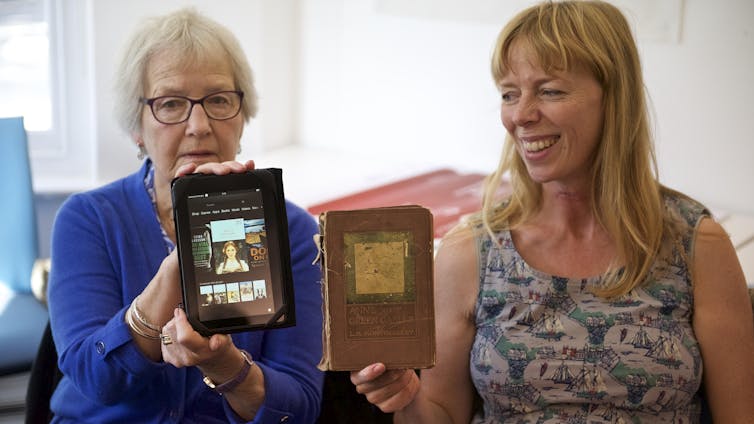
Mother and daughter Barbara and Jenni Creswell enjoyed Anne of Green Gables in both print and ebook format. Ray Gibson, Author provided
But, equally, my research has shown that enhancements in terms of accessibility and mobility offer a lifeline to readers who might not be able to indulge their passion for reading without the digital.
In my latest project, academics from Bournemouth and Brighton universities, in collaboration with Digitales (a participatory media company), worked with readers to produce digital stories based on their reading lives and histories. A recurring theme, especially among older participants, was the scarcity of books in their homes and the fact that literacy and education couldn’t be taken for granted. Our stories also demonstrated how intimately reading is connected with self-worth and helps transform lives disrupted by physical and mental health issues – making comments about any reading as “stupid” particularly damaging and offensive.
I would like to know if Nourry would still call ebooks stupid products after watching Mary Bish’s story: My Life in Books from our project. A lifelong reader who grew up in a home in industrial South Wales with few books, Mary calls her iPad her “best friend” and reflects how before the digital age her reading life would have been cut short by macular degeneration.
As well as demonstrating that fairly basic digital tools can be used to create powerful stories, our project showed that the digital also makes us appreciate anew those features of the physical book we may take for granted, the touch, smell and feel of paper and the special place that a book handed down from generation to generation has in the context of family life.
Bronwen Thomas, Professor of English and New Media, Bournemouth University
This article was originally published on The Conversation. Read the original article.
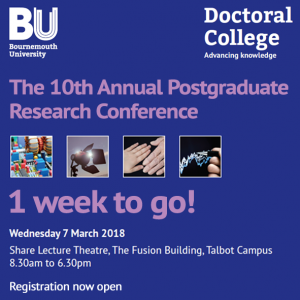 The Doctoral College kindly invites you to attend the 10th Annual Postgraduate Research Conference taking place in the Fusion Building, Talbot Campus.
The Doctoral College kindly invites you to attend the 10th Annual Postgraduate Research Conference taking place in the Fusion Building, Talbot Campus.
The Annual Postgraduate Research Conference is an opportunity to listen to and engage with current postgraduate research taking place at BU. Organised and hosted by the Doctoral College this cross-faculty and interdisciplinary conference supports postgraduate researchers at all stages in presenting their research to their peers and colleagues across BU.
There will be oral, poster and photography presentations taking place throughout the day with a networking opportunity at the end.
If you have any questions please email pgconference@bournemouth.ac.uk. We look forward to seeing you.

Call for submission of a further 18 matched funded Postgraduate Research Projects now OPEN
The Doctoral College is delighted to announce the launch of a second round for the 2018 BU PhD Studentship Competition, with up to 18 further matched funded projects available.
At this stage, Academic Staff are invited to submit proposals for matched funded studentship projects which, if successful, will be advertised to recruit PhD candidates for a September 2018 start.
Full details can be found on the Doctoral College Staff Intranet where the following information can be found:
Submission Deadline:
Applications should be submitted on the Studentship Proposal Form to the Doctoral College via email to phdstudentshipcompetition@bournemouth.ac.uk no later than 5pm on Monday 26 March 2018.
The Doctoral College will manage the recruitment process along the following timetable:
| Date | Action |
| February 2018 | Launch PhD Studentships Internal Competition – development of proposals |
| 26 March 2018 | Closing date for submission of proposals |
| w/c 2 April 2018 | Faculty panel meetings to rank projects |
| w/c 16 April 2018 | Central panel meeting to allocate funding |
| 14 May 2018 | Launch PhD Studentships External Competition – recruitment of candidates |
| 30 June 2018 | Closing date for External Competition |
| September 2018 | Successful Candidates start |
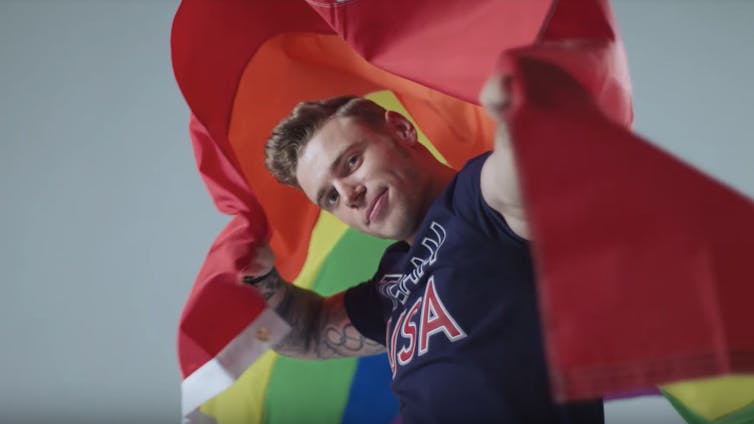
American skiier Gus Kenworthy is one of many openly gay athletes competing in Pyeongchang. Head & Shoulders
By Keith Parry, Western Sydney University; Emma Kavanagh, Bournemouth University, and Ryan Storr, Western Sydney University.
Athletes from Western nations have various protections, and many now share equal rights in most aspects of the law. But when they travel to compete in countries with regressive human rights records, these protections can be lost.
Australia competed at the 2014 Winter Olympics and the 2017 FIFA Confederations Cup, both of which were held in Russia. It will again send a team to Russia to play in this year’s FIFA World Cup and aims to compete in the 2022 edition in Qatar. Both countries have poor human rights records, particularly on LGBTI+ issues.
Sport is often lauded as a platform to advance human rights. But, for LGBTI+ individuals and athletes, this may not necessarily be true. The continued hosting of mega sporting events in countries with anti-LGBTI+ laws brings the role of sport in campaigns to advance human rights into focus.
Read more:
Australia has finally achieved marriage equality, but there’s a lot more to be done on LGBTI rights
Sochi became a platform for LGBTI+ rights when Western activists called for a boycott based on several human rights concerns. Their resistance increased in direct response to the implementation of laws in Russia outlawing sexual minorities.
Principle 4 of the Fundamental Principles of Olympism was often referred to amid concerns for the safety of LGBTI+ athletes at Sochi:
The practice of sport is a human right. Every individual must have the possibility of practising sport, without discrimination of any kind and in the Olympic spirit, which requires mutual understanding with a spirit of friendship, solidarity and fair play.
Athlete activists have begun to challenge the hosting of mega sporting events in countries like Russia that ignore human rights and reinforce systems of oppression. But what has really changed since Sochi for Olympians?
Read more:
Sport, Sochi and the rising challenge of the activist athlete
This year a country with a questionable stance on LGBTI+ rights is again hosting the Winter Olympics. South Korea scores only 13% on the Rainbow Index, which measures the impacts of a country’s laws and policies on the lives of LGBTI+ people. This is only a marginally better score than Russia’s 8%.
Although homosexuality is legal in South Korea, LGBTI+ rights remain highly volatile. South Korean President Moon Jae-in has courted controversy with comments opposing homosexuality, and sexual minorities continue to face significant stigma in the region.
Australia is taking 51 athletes to compete in South Korea, with two openly gay women on the team. One, Belle Brockhoff, has criticised the anti-LGBTI+ laws in host countries. She joined 26 other athletes who signed a letter opposing Kazakhstan’s bid to host the 2022 Winter Olympics due to its anti-LGBTI+ policies.
However, it is not only host nations that can be called to account for their poor LGBTI+ records. Adam Rippon, an openly gay figure skater who has won bronze in Pyeongchang, recently said he did not want to meet Vice President Mike Pence as part of an official reception for the US team. Rippon argued the Trump administration does not “represent the values that [he] was taught growing up”.
A Fox News executive has criticised the inclusion of “African-Americans, Asians and openly gay athletes” in the US team. He claimed that “Darker, Gayer, Different” was now a more suitable Olympic motto than “Faster, Higher, Stronger”.
Current evidence suggests that anti-LGBTI+ discrimination is rising. Stonewall, the UK’s leading LGBTI+ charity, reports hate crimes toward the LGBTI+ community have increased: one in five LGBTI+ people have experienced a hate crime due to their sexual orientation or gender identity in the last year.
In the US, Donald Trump tried to ban transgender people from serving in the military. Several states have attempted to pass laws to restrict access to bathrooms for people who are trans or gender-diverse.
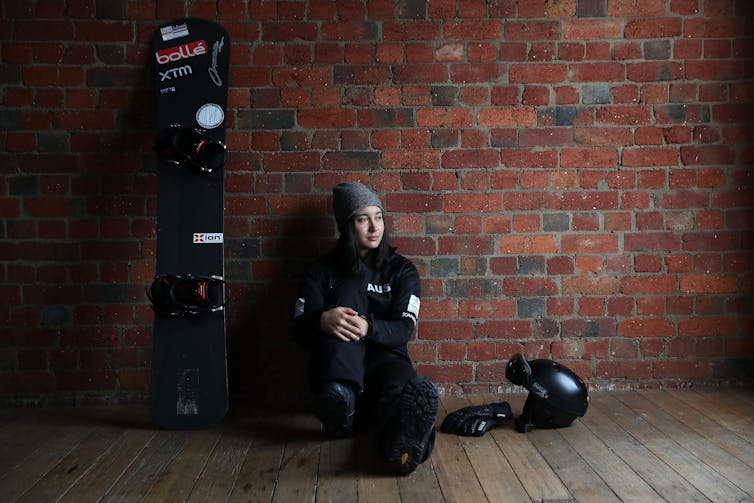
Australian snowboarder Belle Brockhoff has publicly criticised the anti-LGBTI+ laws in Olympic host countries. Robert Cianflone/Getty Images
An increasing number of athletes now openly demonstrate their sexual orientation, but many acknowledge it leaves them open to homophobic abuse – especially on social media platforms.
American Olympic skier Gus Kenworthy referred to social media as a space that serves to reinforce the presence of casual and aggressive homophobia. British Olympian Tom Bosworth said he believed fear of abuse on social media could be preventing athletes from coming out.
We're here. We're queer. Get used to it. @Adaripp #Olympics #OpeningCeremony pic.twitter.com/OCeiqiY6BN
— Gus Kenworthy (@guskenworthy) February 9, 2018
Mega sporting events can be problematic for LGBTI+ athletes as many may not be “out” and there can be serious implications if they were to do so.
The safety and welfare of LGBTI+ athletes made headlines when a journalist went undercover in the athletes’ village at the 2016 Rio Olympics to identify out or closeted athletes. Several athletes who were identified were from countries where being gay is criminalised or even punishable by death.
Sport is responding at a notably slow pace to the advancement of LGBTI+ human rights.
Major sporting codes have shown they are not ready to tackle trans and gender diversity. For example, the Australian Football League recently banned transgender player Hannah Mouncey from joining its women’s competition.
Read more:
By excluding Hannah Mouncey, the AFL’s inclusion policy has failed a key test
There is still much work to be done around athletes with intersex variations, sex testing in elite-level competition, and transgender and transitioned athletes.
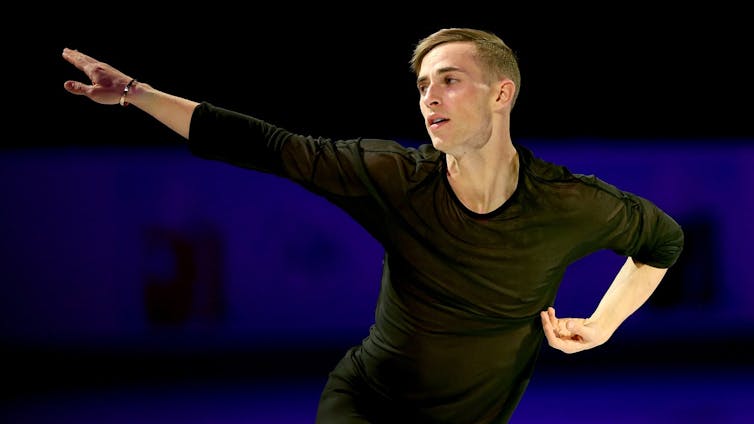
Ice skater Adam Rippon said he did want to meet US Vice President Mike Pence due to the Trump administration’s record on LGBTI+ rights. Matthew Stockman/Getty
One particular social inclusion legacy to come from a mega sporting event is Pride House International. This initiative provides a safe space for the LGBTI+ community to engage with a sporting event.
In addition, the Principle 6 campaign, launched in response to Russia’s anti-LGBT laws, led to the expansion of that particular part of the Olympic Charter to include sexual orientation as something sport should be free from discrimination on.
It will be interesting to see whether the 2018 Winter Olympics can contribute to the advancement of LGBTI+ rights within South Korea and beyond. However, more scrutiny must be directed to the human rights records of potential host nations when awarding mega sporting events.
Keith Parry, Senior Lecturer in Sport Management, Western Sydney University; Emma Kavanagh, Senior Lecturer in Sports Psychology and Coaching Sciences, Bournemouth University, and Ryan Storr, Lecturer in Sport Development, Western Sydney University
This article was originally published on The Conversation. Read the original article.
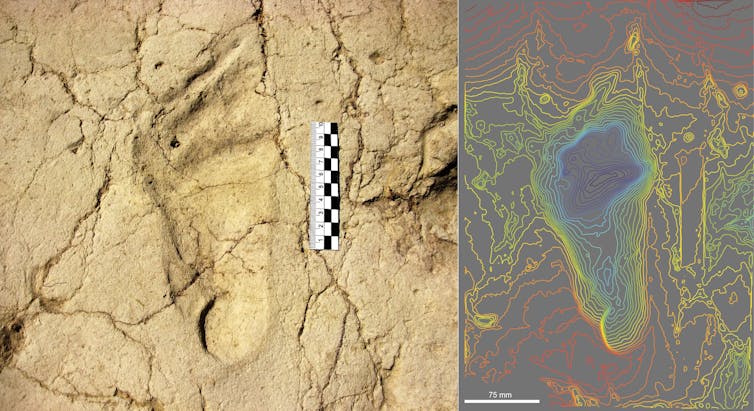
Footprint from 700,000 years ago. Matthew Bennett, Author provided
By Professor Matthew Bennett and Dr Sally Reynolds.
Western society has a rather specific view of what a good childhood should be like; protecting, sheltering and legislating to ensure compliance with it. However, perceptions of childhood vary greatly with geography, culture and time. What was it like to be a child in prehistoric times, for example – in the absence of toys, tablets and television?
In our new paper, published in Scientific Reports, we outline the discovery of children’s footprints in Ethiopia which show how children spent their time 700,000 years ago.
We first came across the question of what footprints can tell us about past childhood experiences a few years back while studying some astonishingly beautiful children’s footprints in Namibia, just south of Walvis Bay. In archaeological terms the tracks were young, dating only from around 1,500 years ago. They were made by a small group of children walking across a drying mud surface after a flock of sheep or goats. Some of these tracks were made by children as young as three-years-old in the company of slightly older children and perhaps young adolescents.
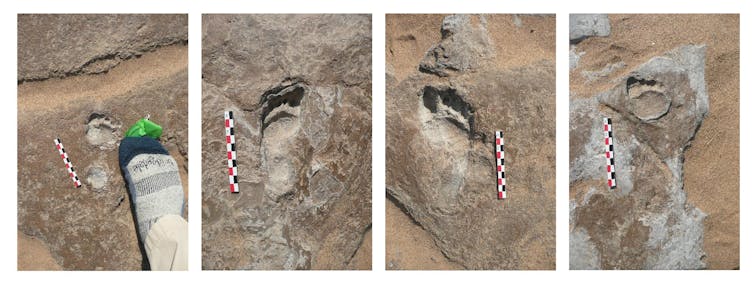
Namibian footprints. Matthew Bennett, Author provided
The detail in these tracks, preserved beneath the shifting sands of the Namibian Sand Sea, is amazing, and the pattern of footfall – with the occasional skip, hop and jump – shows they were being playful. The site also showed that children were trusted with the family flock of animals from an early age and, one assumes, they learnt from that experience how to function as adults were expected to within that culture.
But what about the childhood of our earlier ancestors – those that came before anatomically modern humans (Homo sapiens)? Children’s tracks by Homo antecessor (1.2m to 800,000 years ago) were found at Happisburgh in East Anglia, a site dating to a million years ago. Sadly though, these tracks leave no insight into what these children were doing.
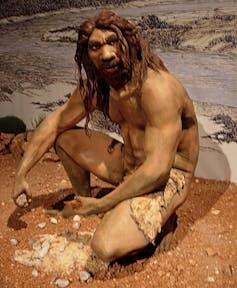
Reconstruction of Homo Heidelbergensis. Jose Luis Martinez Alvarez/wikipedia, CC BY-SA
This assemblage of tracks is capped by an ash flow from a nearby volcano which has been dated to 700,000 years ago. The ash flow was deposited shortly after the tracks were left, although we don’t know precisely how soon after. The tracks are not as anatomically distinct as those from Namibia but they are smaller and may have been made by children as young as one or two, standing in the mud while their parents and older siblings got on with their activities. This included knapping the stone tools with which they butchered the carcass of the hippo.
The findings create a unique and momentary insight into the world of a child long ago. They clearly were not left at home with a babysitter when the parents were hunting. In the harsh savannah plains of the East African Rift Valley, it was natural to bring your children to such daily tasks, perhaps so they could observe and learn.
This is not surprising, when one considers the wealth of ethnographic evidence from modern, culturally distinct human societies. Babies and children are most often seen as the lowliest members of their social and family groups. They are often expected to contribute to activities that support the mother, and the wider family group, according to their abilities. In many societies, small boys tend to help with herding, while young girls are preferred as babysitters. Interestingly, adult tools – like axes, knives, machetes, even guns – are often freely available to children as a way of learning.
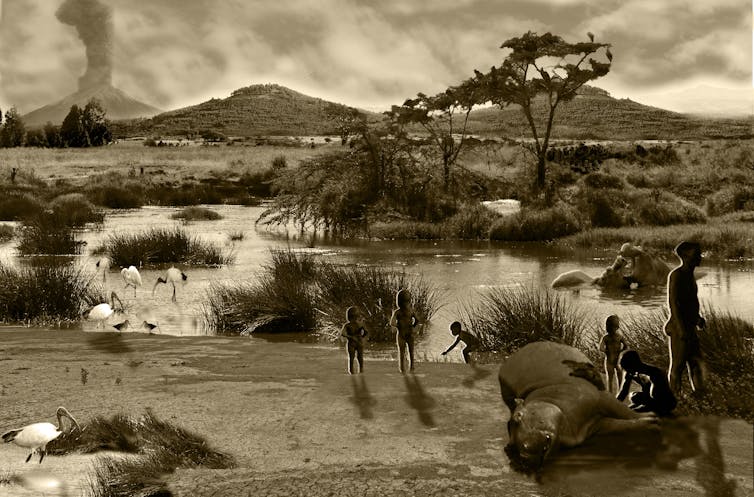
Artistic impression of scene at Melka Kunture. Matthew Bennett, Author provided
So, if we picture the scene at Melka Kunture, the children observing the butchery were probably allowed to handle stone tools and practice their skills on discarded pieces of carcass while staying out of the way of the fully-occupied adults. This was their school room, and the curriculum was the acquisition of survival skills. There was little time or space to simply be a child, in the sense that we would recognise today.
This was likely the case for a very long time. The Monte Hermoso Human Footprint Site in Argentina (roughly 7,000-years-old) contains predominantly small tracks (of children and women) preserved in coastal sediments and it has been suggested that the children may have played an important role in gathering seafood or coastal resources. Similarly, most of the tracks in the Tuc d’Audoubert Cave in France (15,000-years-old) are those of children and the art there is striking. Perhaps they were present when it was carved and painted?
However, these observations contrasts to the story that emerged last year based on tracks from the older Homo Homo erectus (1.5m-year-old) at Ileret, located further south in the Rift Valley, just within the northern border of Kenya. Here the tracks have been interpreted as the product of adult hunting groups moving along a lake shore, rather than a domestic scene such as that at Melka Kunture. However, these scenes aren’t mutually exclusive and both show the power of footprints to provide a snapshot into past hominin behaviour.
But it does seem like the overwhelming parenting lesson from the distant past is that children had more responsibilities, less adult supervision and certainly no indulgence from their parents. It is a picture of a childhood very different from our own, at least from the privileged perspective of life in Western society.
Matthew Robert Bennett, Professor of Environmental and Geographical Sciences, Bournemouth University and Sally Christine Reynolds, Senior Lecturer in Hominin Palaeoecology, Bournemouth University
This article was originally published on The Conversation. Read the original article.

We are delighted to announce the registration for the
10th Annual Postgraduate Research Conference 2018 is now open!
More information about registration and booking are available from our registration page.
More details about the conference can be found at the website.
We look forward to welcoming you all at the conference.
 Call for submission of a further 18 matched funded Postgraduate Research Projects now OPEN
Call for submission of a further 18 matched funded Postgraduate Research Projects now OPEN
The Doctoral College is delighted to announce the launch of a second round for the 2018 BU PhD Studentship Competition, with up to 18 further matched funded projects available.
At this stage, Academic Staff are invited to submit proposals for matched funded studentship projects which, if successful, will be advertised to recruit PhD candidates for a September 2018 start.
Full details can be found on the Doctoral College Staff Intranet where the following information can be found:
Submission Deadline:
Applications should be submitted on the Studentship Proposal Form to the Doctoral College via email to phdstudentshipcompetition@bournemouth.ac.uk no later than 5pm on Monday 26 March 2018.
The Doctoral College will manage the recruitment process along the following timetable:
| Date | Action |
| February 2018 | Launch PhD Studentships Internal Competition – development of proposals |
| 26 March 2018 | Closing date for submission of proposals |
| w/c 2 April 2018 | Faculty panel meetings to rank projects |
| w/c 16 April 2018 | Central panel meeting to allocate funding |
| 14 May 2018 | Launch PhD Studentships External Competition – recruitment of candidates |
| 30 June 2018 | Closing date for External Competition |
| September 2018 | Successful Candidates start |
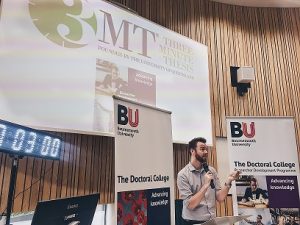
Only a few more days left to get your application in for the inaugural Three Minute Thesis (3MT) competition ⏱.
Find out more information about eligibility, prizes and how to apply on the Doctoral College Research Development Hub.
For any queries please email Natalie or Clare at PGRskillsdevelopment@bournemouth.ac.uk.
We look forward to receiving your application.
Due to an update needed on the server, the research blog will be temporarily unavailable on Tuesday 30th January from 12pm until further notice.
If you have any concerns, please contact the IT Service Desk on 01202 9(65515).
The research blog will be temporarily unavailable on Tuesday 30th January from 12pm until further notice.
This is due to an update on the server.
If you have any concerns, please contact the IT Service Desk on 01202 9(65515).

Do you want to showcase your PhD? Raise the profile of your research? Be in with the chance of winning over £500 worth in prizes?
If the answer is yes to any of the above then the 3MT® might be the opportunity for you.
The 3MT® competition cultivates students’ academic, presentation, and research communication skills.
Presenting in a 3MT® competition increases capacity to effectively explain research in three minutes, in a language appropriate to a non-specialist audience.
Eligibility: Active PhD and Professional Doctorate candidates who have successfully passed their transfer milestone (including candidates whose thesis is under submission) by the date of their first presentation are eligible to participate. If your Viva Voce will take place before the date of the University final (7 June 2018) you are not eligible to enter the competition.
Eligible applicants should submit a fully completed application form, to the Research Skills and Development Officers at PGRskillsdevelopment@bournemouth.ac.uk by midnight on Monday 5 February 2018.
We look forward to receiving your application.

The Doctoral College is happy to announce that this year we will be running the first official Three Minute Thesis (3MT®) event at BU. 3MT® is an academic research communication competition developed by The University of Queensland celebrating the exciting research conducted by PhD students around the world.
The competition cultivates students’ academic, presentation, and research communication skills. Presenting in a 3MT® competition increases capacity to effectively explain research in three minutes, in a language appropriate to a non-specialist audience. Competitors are allowed one static PowerPoint slide, but no other resources or props.
Watch this year’s 3MT® UK finalists presentations which was hosted at the Vitae Researcher Development International Conference where the winner received a £3,000 grant to spend on public engagement activity (sponsored by RCUK).
The BU University winner will receive up to £400 towards a conference of their choice, plus entry into the Vitae National 3MT® competition, plus a £100 Amazon voucher.
In order to be considered for a place in the University heat you must submit a fully completed application form, to PGRskillsdevelopment@bournemouth.ac.uk by midnight on Monday 5 February 2018. For full eligibility, judging and prizes please visit the website.
The last few years have seen our staff and students submitting a wide range of images summing up their research (last year’s entries can be seen here). Photography is a great way to capture and share a different side of your research with other staff, students and members of the public. Nearly 100 images have been entered over the last few years, and we’re looking forward to seeing what this year’s competition brings.
Whether you’re in the early stages of your research or it has come to the end, we are inviting all academics and student researchers from across the university to showcase your research through an image relating to this year’s competition theme ‘People‘. This could include:
Whatever your idea is, we want you to get involved and get creative!
Taking part in the competition is a great way to showcase and raise awareness of your research, as well as growing your academic profile both in and outside the university. You will also be in with a chance of winning some Amazon vouchers!
Step 1: Take your photo.
It’s easy! Grab a camera and take a picture connecting with the theme ‘People‘. Interpret it in any way you see fit to capture any area of your research.
Each image will need to be 300pi (pixels per inch) with physical dimensions equivalent to an A3 size piece of paper (297 x 420 mm or 11.7 x 16.5 in). Images smaller than this tend not to have a high print quality.
Step 2: Submit the photo!
You may enter only one photo per person. Once you have the perfect image, all you have to do is submit it by emailing the Research account (research@bournemouth.ac.uk) before the deadline, along with a 100 – 200 word description of your research behind the image.
The submission deadline is 12 January 2018 at 5pm. Late entries will not be accepted.
Staff, students and the general public will then be able to vote for their favourite image.
The competition winners will be presented with a prize by Professor John Fletcher in the Atrium Art Gallery, in March 2018. All photographs will be presented in the Atrium Art Gallery for two weeks in March so you’ll get a chance to see all the entries.
Please read through the Terms & Conditions before entering.
Take a look at our Photo of the Week, where you can read about the research behind the images from previous entries.
Should you have any queries about the competition then please contact Sacha Gardener, Student Engagement & Communications Coordinator, in the Research and Knowledge Exchange Office.

Photo by Chantel Cox, PhD Student, Faculty of Health and Social Sciences
The last few years have seen our staff and students submitting a wide range of images summing up their research (last year’s entries can be seen here). Photography is a great way to capture and share a different side of your research with other staff, students and members of the public. Nearly 100 images have been entered over the last few years, and we’re looking forward to seeing what this year’s competition brings.
Whether you’re in the early stages of your research or it has come to the end, we are inviting all academics and student researchers from across the university to showcase your research through an image relating to this year’s competition theme ‘People‘. This could include:
Whatever your idea is, we want you to get involved and get creative!
Taking part in the competition is a great way to showcase and raise awareness of your research, as well as growing your academic profile both in and outside the university. You will also be in with a chance of winning some Amazon vouchers!
Step 1: Take your photo.
It’s easy! Grab a camera and take a picture connecting with the theme ‘People‘. Interpret it in any way you see fit to capture any area of your research.
Each image will need to be 300pi (pixels per inch) with physical dimensions equivalent to an A3 size piece of paper (297 x 420 mm or 11.7 x 16.5 in). Images smaller than this tend not to have a high print quality.
Step 2: Submit the photo!
You may enter only one photo per person. Once you have the perfect image, all you have to do is submit it by emailing the Research account (research@bournemouth.ac.uk) before the deadline, along with a 100 – 200 word description of your research behind the image.
The submission deadline is 12 January 2018 at 5pm. Late entries will not be accepted.
Staff, students and the general public will then be able to vote for their favourite image.
The competition winners will be presented with a prize by Professor John Fletcher in the Atrium Art Gallery, in March 2018. All photographs will be presented in the Atrium Art Gallery for two weeks in March so you’ll get a chance to see all the entries.
Please read through the Terms & Conditions before entering.
Take a look at our Photo of the Week, where you can read about the research behind the images from previous entries.
Should you have any queries about the competition then please contact Sacha Gardener, Student Engagement & Communications Coordinator, in the Research and Knowledge Exchange Office.